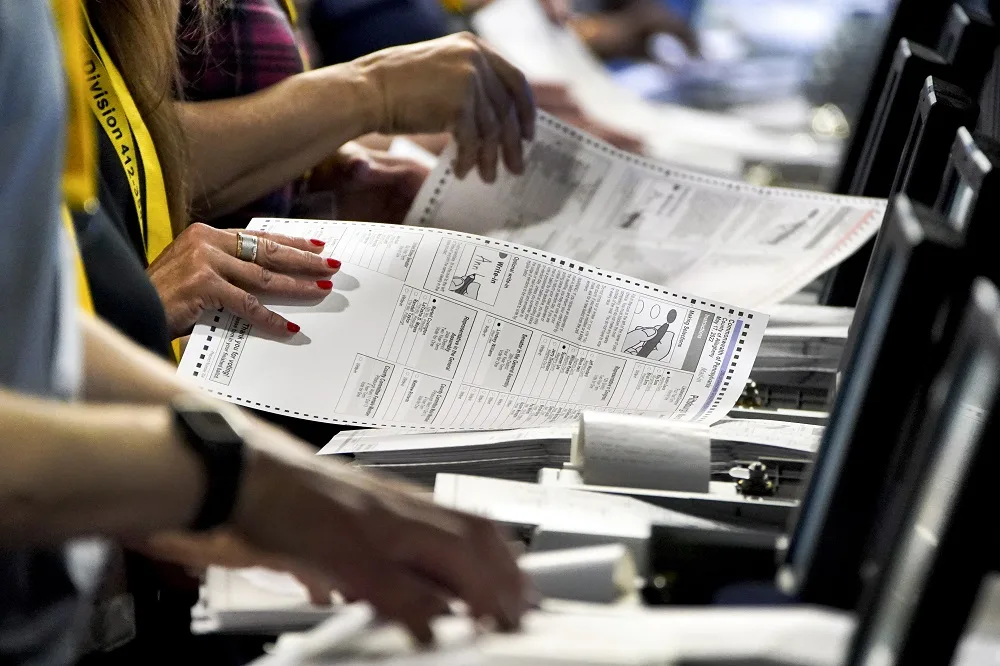WASHINGTON (AP) — With the American electorate so evenly divided, there will be elections in November close enough that officials will have to recount the votes. Just don’t expect those recounts to change the winner. They rarely do, even when the margins are tiny.
“The (original) count is pretty accurate because the machines work — they work very well,” said Tammy Patrick, a former election official in Arizona who is now with the National Association of Election Officials. “We have recounts and we have audits to make sure we got it right.”
There have been 36 recounts in statewide general elections since America’s most famous recount in 2000. That year, Republican George W. Bush maintained his lead over Democrat Al Gore in Florida — and won the presidency — after a recount was stopped by the Supreme Court.
Since then, only three of those statewide recounts resulted in a new winner, and all three were decided by hundreds of votes, not thousands. That’s according to an Associated Press review of statewide recounts using data from the AP vote count, state election offices and research by FairVote, a nonpartisan organization that researches elections and advocates for changes in the way elections are conducted.
Most states allow recounts when the margin between the top candidates falls within a specific margin, such as 0.5 percentage points, even when that means the number of votes separating them is actually in the thousands or even tens of thousands. But there is no precedent for a recount changing the winner in a race with margins that big, at least not since Congress made sweeping changes to U.S. election law in 2002.
The most recent statewide race overturned by a recount was in 2008 in Minnesota. Republican Sen. Norm Coleman led Democrat Al Franken by 215 votes in the initial count, out of more than 2.9 million ballots cast. After a hand recount, Franken won by 225 votes, a shift of 0.02 percentage points, or two one-hundredths of a percentage point.
Among the 36 statewide recounts since 2000, the average change in the winning margin, whether it grew or shrank, was 0.03 percentage points. The biggest shift was 0.11 percentage points in a relatively low turnout race for Vermont auditor in 2006. In that race, incumbent Republican Randy Brock led Democrat Thomas Salmon by 137 votes after the initial count. A recount flipped the race and Salmon won by 102 votes.
Recounts aren’t limited to general elections. They happen in primaries, too.
Earlier this year, the Washington state primary for commissioner of public lands went to a recount after the initial tally had Democrat Dave Upthegrove leading Republican Sue Kuehl Pederson by 51 votes, out of more than 1.9 million votes counted, as they vied for second place.
After the recount, Upthegrove’s lead shrank by just two votes. In Washington’s primary system, the top two candidates advance to the general election, regardless of their political party.
There are even more recounts in downballot races that are sometimes decided by a handful of votes. But even in these lower turnout elections, recounts rarely change the winners.
“Recounts are shifting a very small number of votes,” said Deb Otis, director of research and policy at FairVote. “We’re going to see recounts in 2024 that are not going to change the outcome.”
States have a wide variety of laws on when and how recounts are conducted. Many states have automatic recounts if the margin between the top two candidates is within a certain margin. The most common margin is 0.5 percentage points, but there is a lot of variation. Some states allow candidates to request recounts but require that they pay for them — unless the winner changes.
Alaska, Montana, South Dakota and Texas mandate recounts only if there is an exact tie, though candidates in those states can request a recount. South Carolina has automatic recounts if the margin between the top two candidates is 1% or less of the total votes cast in the race.
The AP may declare a winner in a race that is eligible for a recount if the AP determines the lead is too large for a recount or legal challenge to change the outcome.
In Washington’s public lands primary, which was ultimately decided by 49 votes, the AP waited until after the recount to declare the winner because the margin was so close. But in cases where the number of votes separating the top candidates is larger, for example in a statewide race where the candidates are separated by thousands or tens of thousands of votes, the AP may determine that it’s not possible for a recount to reverse the outcome.
Statewide recounts almost always change the results by a few votes.
Patrick said that’s usually because of human error -– either by an election worker or by voters. For example, paper ballots are often rejected because voters didn’t fill them out correctly, but they might later get added to the count after a review.
Paper ballots usually require voters to fill in little bubbles next to their chosen candidate, just like students taking standardized tests. Tabulation machines count the votes by looking for a mark on a very specific area of the ballot, Patrick said. If voters indicate their preference in some other way, like circling their chosen candidate, the machines won’t count the vote.
In some states, bipartisan panels review rejected ballots to see if they can determine the intent of the voter. Some states do these reviews whether there is a recount or not. Other states only do them if there is a recount. Still others never do these reviews and the ballots are simply rejected.
Patrick said she’s seen ballots marked many different ways that weren’t picked up by the tabulation machines, like voters using crayons or marking their choices with a highlighter.
In the Minnesota recount, a voter filed in the dot for Franken but also wrote “Lizard People” in the box for write-in votes. The ballot was rejected.
“Voters do a lot of very interesting things with their ballots,” Patrick said.
STEPHEN OHLEMACHER Associated Press












